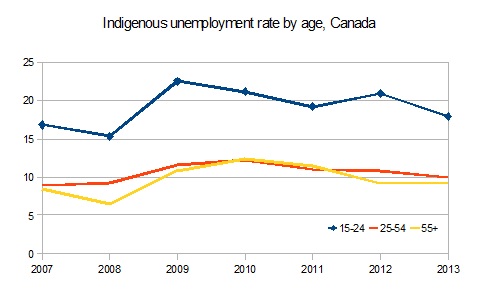Labour market data in Canada is easily available by sex, age, and region. We spend a great deal of time talking about these factors. More recently Statistics Canada made labour market data available on CANSIM by landed immigrant status, going back to 2006. This factor is less often included in most labour market analysis, and too few know that it is even available.
But if you want to know how racialized workers or Indigenous workers (First Nations, Métis, and Inuit peoples) are doing in the labour force you basically have to rely on the census … oh, wait. And on top of eliminating the census, the Harper government shut down the First Nations Statistical Institute.
So imagine my delight when a recent search on the issue turned up an article from the Centre for the Study of Living Standards about Indigenous employment that cited the Labour Force Survey as a source.
I should have already known that the Labour Force Survey asked an Aboriginal identity question, but I didn’t. A quick call to Statistics Canada revealed that this data is freely available on request, but is limited to First Nations, Métis, and Inuit peoples living off reserve (since the LFS doesn’t survey persons living on reserves).
I plan on doing a more thorough analysis, but I thought that I would post a few quick insights, and get the word out so that anyone who is interested can call and get the data for themselves.
Some of this data confirms things that we “know,” but having the hard numbers helps when we’re calling for action. For example, unemployment is a HUGE issue for Indigenous young workers living off reserve, before, during, and after the recession. The unemployment rate reached a high of 22.5 per cent in 2009, and was still 18 per cent in 2013.
While I don’t have the data to calculate underemployment, consider that underemployment rates seem to be about double unemployment rates for the general population. That suggests an underemployment rate of at least 36 per cent for Indigenous young workers in 2013.
Unemployment rates for Indigenous workers are much higher than for non-Indigenous Canadian born workers, and are comparable to that of new Canadians.

As you can tell by the graph, the recession was more severe and lasted longer for Indigenous workers and new Canadians.
So whenever we’re talking about labour market strategies and good jobs, it’s important to keep in mind that for some workers there are systemic barriers that need to be addressed. Hopefully access to labour market data for Indigenous workers and new Canadians can be one way that we convey the need for action.
If you want to read more about Indigenous workers and the labour market in Canada the CSLS has a study using LFS data from 2007 – 2011, the Conference Board of Canada has a more employer driven study from 2012, and a 2011 paper in Aboriginal policy studies by Friedel and Taylor analyzes the colonial discourse in Indigenous labour market development policy in Northern Alberta.



